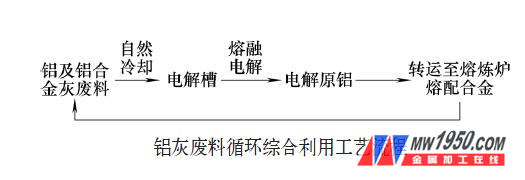1 Overview
Aluminum ash is the waste that aluminum must produce during the smelting process. It can produce about 3% of aluminum ash. The amount of aluminum ash produced annually for large aluminum plants is very large. These aluminum ash wastes accumulate in the plant area and not only cause resources. Waste, but also caused environmental pollution. The main component of aluminum and aluminum alloy aluminum ash (hereinafter referred to as aluminum ash) waste is industrial waste produced by aluminum alloy configuration during casting smelting process, which includes aluminum oxide scale, magnesium oxide scale, and a small amount of aluminum and silicon. Etc., among which metal aluminum and alumina account for the majority, metal aluminum accounts for 20% to 30%, and alumina accounts for more than 70%.
At present, there are many treatment methods for the above industrial waste residue, but all have pollution. For example, the soil waste ash is to put the industrial waste aluminum and aluminum ash waste into a large pot and heat and repeatedly stir to melt and separate the solid aluminum. This method is very inefficient and can only separate solid metal aluminum, and this method will produce industrial waste gas and waste residue during the working process, and the pollution is large. In addition, recycling by electrolysis may adversely affect the electrolytic aluminum process if the above industrial waste is not treated. In this paper, a manufacturing technology of aluminum ash scrap directly used in electrolytic production cycle comprehensive utilization is studied. This technology adopts a new slag-forming agent, which has the characteristics of simple production process, less pollution, and economy.
2. Technical process plan
The technical process flow is shown in the drawing.
The specific implementation scheme is as follows:

Please see the attachment for more details:
Electric valve is a device that drives the valve to open and close by electric motor. It is widely used in various industrial and civil fields, such as metallurgy, chemical industry, petroleum, natural gas, heating, ventilation and air conditioning, automatic control, etc. The following are some application scenarios of electric valves:
1. Fluid control in industrial production: electric valve can be used to control the flow, pressure and temperature of liquid, gas and steam to meet the needs of industrial production.
2. Oil and natural gas industry: electric valves can be used in oil and natural gas exploitation, processing, transmission and storage to control flow and pressure and ensure production safety and efficiency.
3. Chemical industry: electric valve can be used for fluid control in chemical production, such as acid-base solution, gas and liquid reactant control, to ensure the safety and efficiency of production.
4. Heating, ventilation and air conditioning system: the electric valve can be used to control the water flow, air flow and temperature in the heating, ventilation and air conditioning system to meet the requirements of the indoor environment.
5. Automatic control system: electric valve can be used with automatic control system to realize automatic control and adjustment of fluid flow, pressure, temperature and other parameters.
In short, electric valves are widely used in industrial and civil fields, which can improve production efficiency, ensure product quality and improve production safety.
Electric Valve,Electric Air Valve,Electric Control Valve,Electric Exhaust Valve
WUXI KVC-VALVE , https://www.wxkaiweixi.com